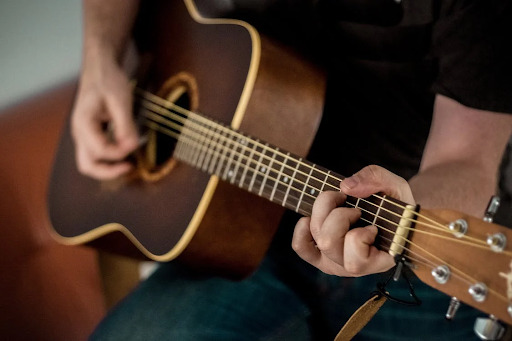
Photo by Allef Vinicius on Unsplash
Playing classical guitar is a rich and rewarding journey. It allows musicians to immerse themselves in the timeless beauty of classical music. The classical guitar offers a unique experience that transcends time and resonates with the depths of human emotion.
Learning to play songs for classical guitar is a journey that opens the doors to a world of timeless beauty and artistic expression. The beauty of this musical journey lies in the enchanting music it produces. And also in the personal growth, discipline, and profound connection with the instrument it fosters.
Read on to unlock the full potential of this enchanting instrument.
Fundamental Classical Guitar Playing Techniques
Here are some basics of playing classical guitars that will help you develop your skills:
1. Proper hand position
A correct hand position is the foundation of playing classical guitar songs. Start by placing your left hand on the neck, then your fingers lightly touching the strings. Curve your fingers as you press down the strings with your fingertips to produce clear notes.
As for your right hand, position it above the soundhole. Your fingers should gently rest on the strings.
This proper hand position will ensure optimal precision and control.
2. Fingerpicking technique
Fingerpicking is a classical guitar technique involving plucking the strings with your fingers – not by a pick. And classical guitars highly rely on this technique.
Start by practicing the rest stroke. This refers to the fingers plucking the strings and landing on the adjacent string to produce a rich sound.
Next, practice free stroke. This involves plucking the strings and letting fingers rest on the neighboring string but not touching it.
Mastering both strokes will help you articulate harmonies and melodies with clarity.
3. Arpeggios and fingerstyle patterns
Arpeggios are a vital part of becoming a classical guitarist. This technique involves playing individual notes in a sequential manner, ascending or descending.
Among the patterns you must practice are the following:
- Pima pattern (thumb, index, middle, and ring fingers) – this develops dexterity and control
- Spanish Romance – this helps expand your classical guitar repertoire
4. Dynamics and expression
Classical guitar music is known for its expressiveness and emotive qualities. To convey the intended mood and atmosphere of a piece, understand dynamics and expression.
Experiment with playing softly (piano). Then, gradually build up to louder (forte) sections.
Additionally, explore the following techniques:
- Vibrato – slightly fluctuates the pitch of a note
- Legato – smoothly connecting notes together
These techniques will add depth and nuance to your interpretation.
5. Sight-reading and interpretation
Developing sight-reading skills is crucial for learning new classical guitar pieces. Practice reading sheet music. Then, familiarize yourself with common notation symbols, rhythms, and musical phrasing.
As you progress, focus on interpreting the music and capturing its essence. Also, add your personal touch to each performance. Experiment with different tempos, dynamics, and expressive techniques.
Additional Tips for Developing Your Skills for Classical Guitar Songs
Here are additional tips to excel in playing classical guitar songs:
6. Practicing basic exercises
Start with basic exercises to improve finger dexterity and strength. Scales, such as the popular A minor or C major, help familiarize yourself with the fretboard. This will also improve coordination between the hands.
Additionally, exercises like chromatic runs and trills enhance finger agility and control.
Consistent practice of these fundamental exercises will bolster your overall technique.
7. Building a repertoire
Expanding your repertoire is a crucial part of skill development.
Begin by learning simple classical guitar songs. Try traditional folk tunes or beginner-level compositions.
As you progress, tackle more challenging pieces from renowned composers.
Building a diverse repertoire will expose you to different musical styles and techniques. It will also foster growth and versatility in your playing.
8. Embrace technical exercises
Technical exercises specifically designed for classical guitar provide targeted improvement in various areas. Incorporate activities that focus on finger independence. They may include the Giuliani 120 Right-Hand Studies or the Segovia Scales.
These exercises enhance finger coordination, speed, and accuracy. They will enable you to tackle intricate passages in classical guitar songs confidently.
9. Performance and musicianship
Developing your skills for classical guitar songs goes beyond technical proficiency. Focus on aspects of musicianship, such as phrasing, dynamics, and expression.
Practice playing with feeling and nuance. Aim to convey the intended emotions of each composition.
Seek opportunities to perform to gain confidence and polish your stage presence. You can perform in small gatherings or open mic nights.
10. Seek guidance and feedback
Enlist the guidance of a qualified classical guitar teacher or mentor. Their expertise and personalized instruction can accelerate your progress significantly.
A teacher can help identify areas for improvement. They can offer guidance on technique and provide valuable feedback on your playing.
Regular classical guitar lessons and constructive criticism will assist you in refining your skills and expanding your musicality. You’ll be one of the most skilled classical guitarists in no time.
Conclusion
Playing classical guitar songs is a beautiful and intricate art form. But it requires dedication, practice, and a solid foundation of essential techniques. Pick up your classical guitar and embrace these techniques. Let the captivating melodies of classical music resonate through your fingertips. Have fun!
© 2023, Seth "Digital Crates" Barmash. All rights reserved.










